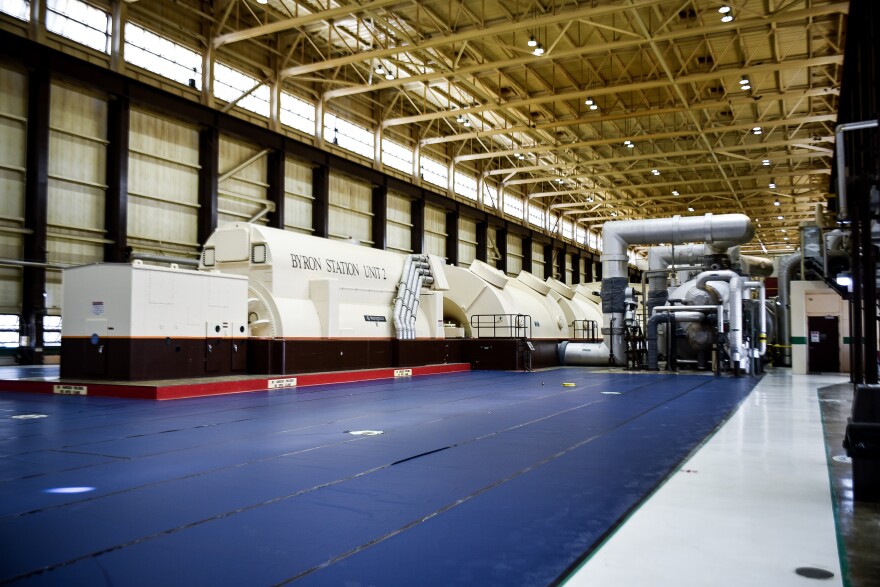For some people, their first thought of a nuclear power plant involves cooling towers, meltdowns, and the comically incompetent Homer Simpson. But needless to say, The Simpsons is not an accurate representation of a nuclear power plant. Like coal, oil, and gas plants, nuclear power stations use heat to generate electricity. But they're subject to many more safety precautions because their fuel -- uranium -- is radioactive.

Uranium releases heat when its atoms split, also known as fission. This happens at a fixed rate in nature, but can go faster by bombarding the atoms with neutrons. Once the atoms split, they release more heat and neutrons, hitting other uranium atoms and causing a chain reaction. But the most common variety of uranium can't sustain a reaction like this on its own. To remedy this, power plants enrich their uranium fuel with an isotope called Uranium-235. Byron's Operating Site Vice President, Mark Kanavos, says they enrich their uranium by about five percent.
"A nuclear submarine, which has fuel, is enriched almost to a hundred percent," he said. "So we have a license with the Nuclear Regulatory Commission which only allows us to enrich to a certain point.”

To fuel a nuclear reactor, uranium pellets are packed into large metal rods, and then bundled together into groups of at least 150 rods. Each of Byron's two reactors have almost 200 of these bundles submerged in water as their main source of fuel. Once the fuel is in place, plant workers can control how much the surrounding water is heated by changing how much the fuel is exposed to neutrons.
To generate power, some nuclear plants convert the water directly into steam, but Kanavos says the Byron plant's reactor has a different design.
https://vimeo.com/132116500">Pressurized Water Reactor Animation from https://vimeo.com/tnvalleyauthority">TVA on Vimeo.
"We pressurize the water to above 2,200 pounds to make sure it doesn't boil. It then goes through a very large heat exchanger that we call a steam generator. That generates the steam which turns the turbine, which makes electricity," he said.
The turbine is in the upper floors of the plant, and at more than 1,800 rpm, it is loud.

The water used in the steam generator never comes into physical contact with the irradiated water by the reactor, so it can be pumped in from the Rock River and used for evaporation. As part of the condenser used to cool the steam, it's safely expelled as water vapor in the cooling towers. For plants without these towers, the water is usually discharged into a nearby lake or river, warmer than when it came in.
But running a reactor and its components is a carefully monitored operation. And for that, there's an extensive control room.
The walls are lined with dials, buttons and gauges monitoring everything from steam pressure and electricity flow, to regulating the reactor core.
"All of the control rods are fully withdrawn from the reactor," Kanavos said. "If we were to trip the reactor or the reactor would trip, all of those lights would go down, which would indicate all the control rods inserted into the reactor and stop the nuclear reaction."
A trip, sometimes also called a SCRAM, is an automatic shutdown that would occur in case of an emergency. But Site Vice President Kanavos says there will never be a Homer Simpson situation, because the board operators never work alone.
"We'll have one senior reactor operator and a shift operator who's basically in charge of the whole shift in the whole periphery," he said.
And under that group is at least two operators manning each reactor in 12-hour shifts. The plant also has inspectors from the Nuclear Regulatory Commission and Illinois Emergency Management Association on site at all times.

But if any of the reactor systems do lose power, the Byron plant has four diesel generators, two for each reactor, that can spring to life at a moment's notice. Kanavos says the engines are comparable in size and power to a locomotive.
"Ten cylinders on each side, so it's a 20-cylinder engine and they're big size. It's not a Hyundai."

But the nuclear fuel can’t generate power forever. Every 18 months, one of the reactors needs to be shut down. Exelon Nuclear spokesman Paul Dempsey explains.
“They’ll pull this bundle out underwater. They’ll move it to a transfer canal, and then we’ll move it into the fuel pool. We’ll do that with all the fuel in the reactor during an outage. We’ll do a bunch of work over a few weeks time, Then we’ll load 2/3 of that older fuel into the core and a third of brand new fuel," he said.

This September, Byron will carry out one of these refuelings, bringing countless contractors, technicians, and specialists. Once that’s done the plant will be back up to full power.


